1994 PONTIAC GRAND-AM steering
[x] Cancel search: steeringPage 123 of 274
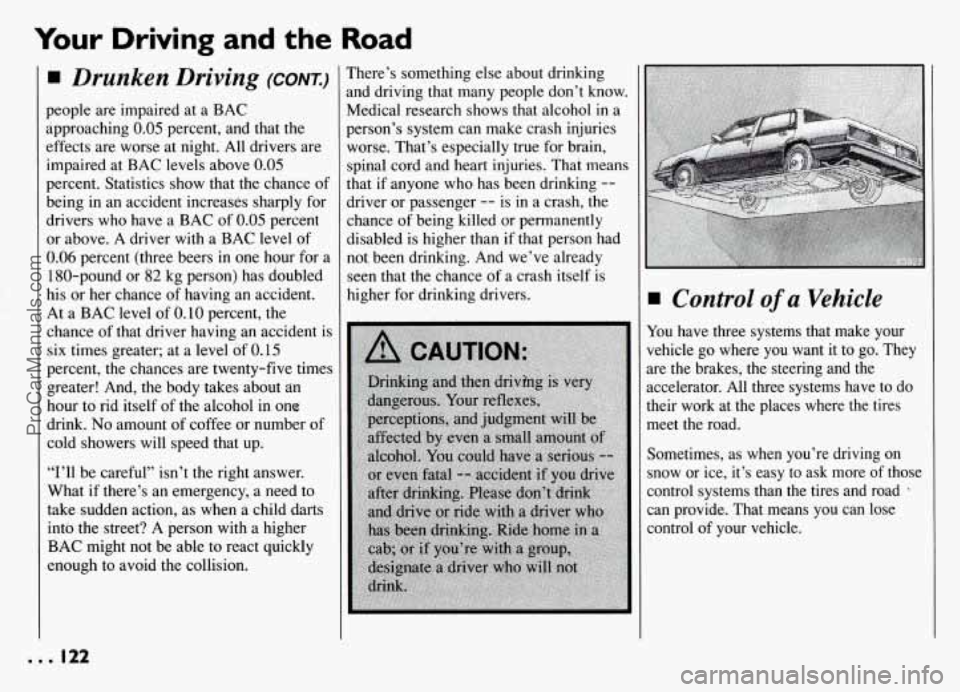
Your Driving and the Road
Drunken Driving (CONTI
people are impaired at a BAC
approaching
0.05 percent, and that the
effects are worse at night. All drivers are
impaired at BAC levels above
0.05
percent. Statistics show that the chance of
being in an accident increases sharply for
drivers who have a BAC of
0.05 percent
or above. A driver with a BAC level of
0.06 percent (three beers in one hour for a
180-pound or
82 kg person) has doubled
his or her chance of having an accident.
At a BAC level of
0.10 percent, the
chance of that driver having an accident is
six times greater; at a level of 0.15
percent, the chances are twenty-five times
greater! And, the body takes about an
hour to rid itself of the alcohol in on@
drink.
No amount of coffee or number of
cold showers will speed that up.
“I’ll be careful” isn’t the right answer.
What if there’s an emergency, a need to
take sudden action, as when a child darts
into the street? A person with a higher
BAC might not be able to react quickly
enough to avoid the collision.
There’s something else about drinking
and driving that many people don’t know.
Medical research shows that alcohol in a
person’s system can make crash injuries
worse. That’s especially true for brain,
spinal cord and heart injuries. That means
that if anyone who has been drinking
--
driver or passenger -- is in a crash, the
chance of being killed or permanently
disabled
is higher than if that person had
not. been drinking. And we’ve already
seen that the chance of a crash itself is
higher for drinking drivers.
Control of a Vehicle
You have three systems that make your
vehicle
go where you want it to go. They
are the brakes, the steering and the
accelerator. All three systems have to do
their work at the places where the tires meet the road.
Sometimes, as when you’re driving on
snow or ice, it’s easy
to ask more of those
control systems than the tires and road
a
can provide. That means you can lose
control of your vehicle.
ProCarManuals.com
Page 126 of 274
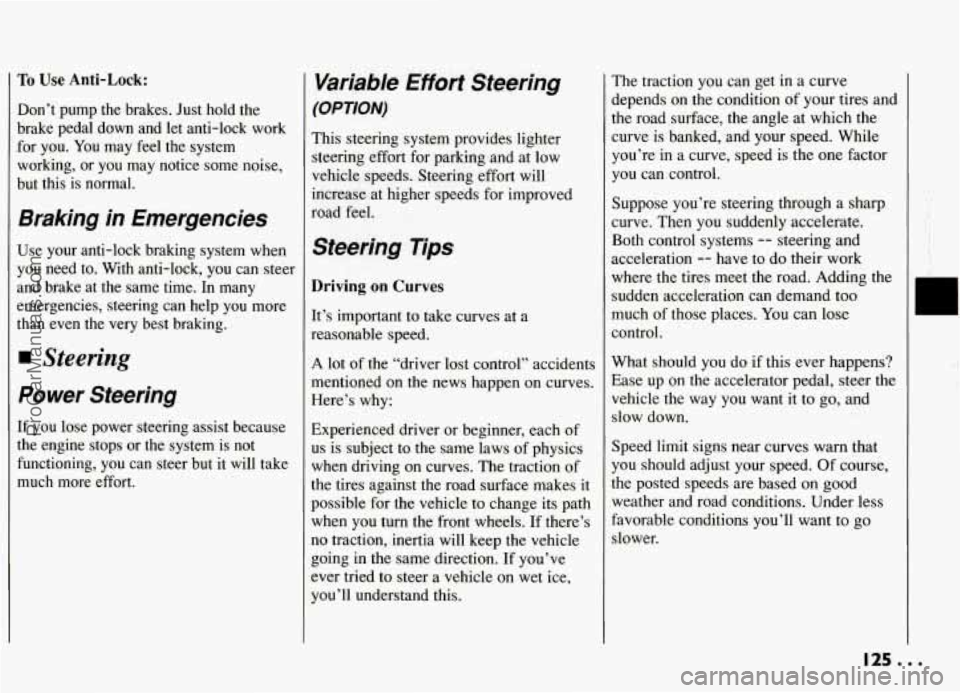
To Use Anti-Lock:
Don’t pump the brakes. Just hold the
brake pedal down and let anti-lock work
.for you. You may feel the system
working, or you may notice some noise,
but this is normal.
Braking in Emergencies
Use your anti-lock braking system when
you need to. With anti-lock, you can steer
and brake at the same time. In many
emergencies, steering can help you more
than even the very best braking.
Steering
Power Steering
If you lose power steering assist because
the engine stops or the system is not
functioning, you can steer but it will take
much more effort.
Variable Effort Steering
(OPTION)
This steering system provides lighter
steering effort for parking and at low
vehicle speeds. Steering effort will
increase at higher speeds for improved
road feel.
Steering Tips
Driving on Curves
It’s important to take curves at a
reasonable speed.
A lot of the “driver lost control” accidents
mentioned on the news happen on curves.
Here’s why:
Experienced driver or beginner, each of
us is subject to the same laws of physics
when driving on curves. The traction of
the tires against the road surface makes it
possible
for the vehicle to change its path
when you
turn the front wheels. If there’s
no traction, inertia will keep the vehicle
going in the same direction. If you’ve
ever tried to steer a vehicle on wet ice,
you’ll understand this.
The traction you can get in a curve
depends on the condition of your tires and
the road ,surface, the angle at which the
curve is banked, and your speed. While
you’re in a curve, speed isthe one factor
you can control.
Suppose you’re steering through a sharp
curve. Then you suddenly accelerate.
Both control systems
-- steering and
acceleration
-- have to do their work
where the tires meet the road. Adding the
sudden acceleration can demand too
much of those places. You can lose
control.
What should you do if this ever happens?
Ease up on the accelerator pedal, steer the
vehicle the way you want it to go, and
slow down.
Speed limit signs near curves warn that
you should adjust your speed. Of course,
the posted speeds are based on good
weather and road conditions. Under less
favorable conditions you’ll want
to go
slower.
I
125...
ProCarManuals.com
Page 127 of 274
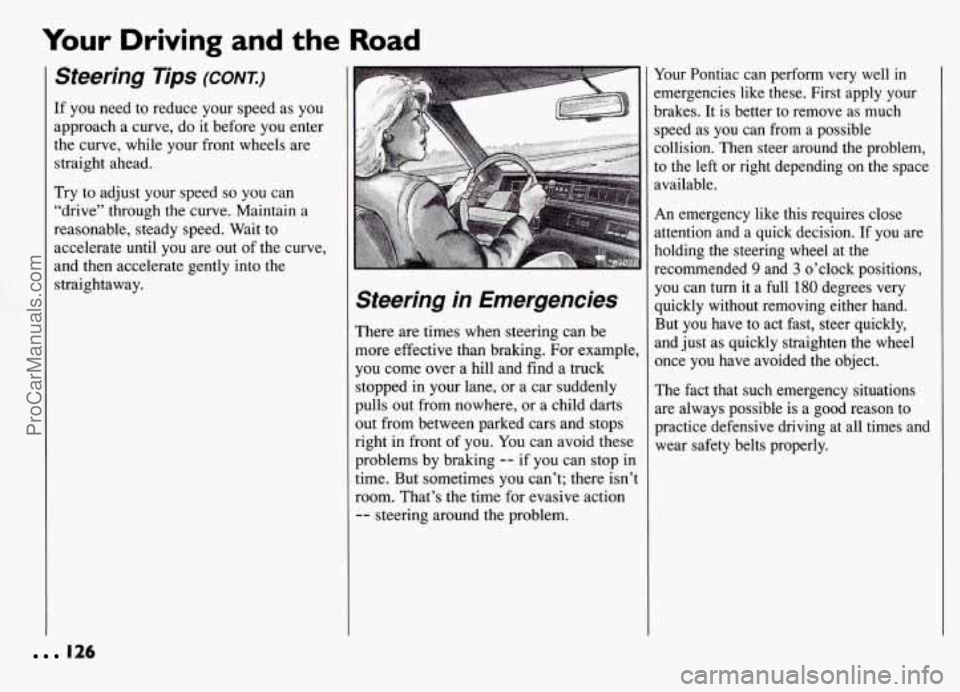
Your Driving and the Road
Steering Tips (CONT.)
If you need to reduce your speed as you
approach a curve, do it before you enter
the curve, while your front wheels are
straight ahead.
Try to adjust your speed so you can
“drive” through the curve. Maintain a
reasonable, steady speed. Wait to
accelerate until you are out of the curve,
and then accelerate gently into the
straightaway.
I .. ..
I
Steering in Emergencies
There are times when steering can be
more effective than braking. For example,
you come over a
hill and find a truck
stopped in your lane, or a car suddenly
pulls out from nowhere, or a child darts
out from between parked cars and stops
right in front of you. You can avoid these
problems by braking
-- if you can stop in
time. But sometimes you can’t; there isn’t
room. That’s the time for evasive action
-- steering around the problem.
Your Pontiac can perform very well in
=mergencies like these. First apply your
brakes. It is better to remove as much
speed as you can from a possible
Zollision. Then steer around the problem,
to the left or right depending on the space
mailable.
An emergency like this requires close
attention and a quick decision. If you are
holding the steering wheel at the
recommended
9 and 3 o’clock positions,
you can turn it a full
180 degrees very
quickly without removing either hand.
But you have to act fast, steer quickly,
and just as quickly straighten the wheel
once you have avoided the object.
The fact that such emergency situations
are always possible is a
good reason to
practice defensive driving at all times and
wear safety belts properly.
126
ProCarManuals.com
Page 128 of 274
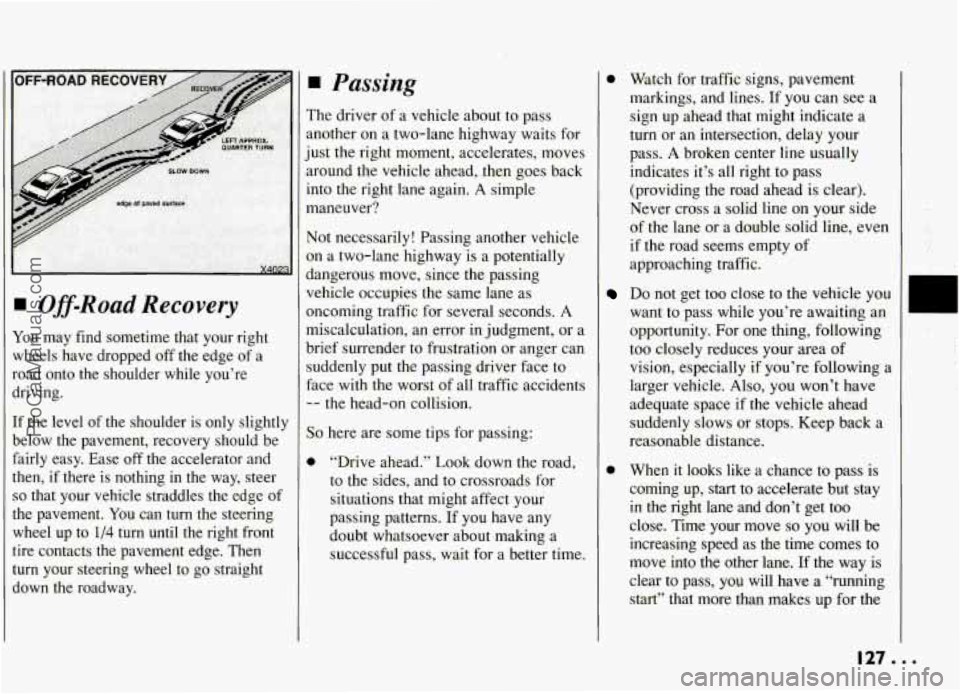
Off-Road Recovery
You may find sometime that your right
wheels have dropped’off the edge of a
road onto the shoulder while you’re
driving.
If the level of the shoulder is only slightlJ
below the pavement, recovery should be fairly easy. Ease off the accelerator and
then, if there is nothing in the way, steer
so that your vehicle straddles the edge of
the pavement.
You can turn the steering
wheel up to
1/4 turn until the right front
tire contacts the pavement edge. Then
turn your steering wheel to go straight
down the roadway.
<
1
(
I
I
1
7
4 Passing
The driver of a vehicle about to pass
another on
a two-lane highway waits for
just the right moment, accelerates, moves
around the vehicle ahead, dhen goes back
into the right lane again.
A simple
maneuver?
Not necessarily! Passing another vehicle
on a two-lane highway is a potentially
dangerous move, since the passing
vehicle occupies the same lane as
oncoming traffic for several seconds.
A
miscalculation, an error in judgment, or a
brief surrender
to frustration or anger can
suddenly put the passing driver face to
face with the worst of all traffic accidents
-- the head-on collision.
So here are some tips for passing:
0 “Drive ahead.” Look down the road,
to the sides, and to crossroads for
situations that might affect your
passing patterns. If you have any
doubt whatsoever about making a
successful pass, wait for
a better time.
0
0
Watch for traffic signs, pavement
markings, and lines. If you can see a
sign up ahead that might indicate a
turn or an intersection, delay your
pass.
A broken center line usually
indicates it’s all right to pass
(providing the road ahead is clear).
Never cross a solid line on your side
of the lane or a double solid line, even
if the road seems empty
of
approaching traffic.
Do not get too close to the vehicle you
want to pass while you’re awaiting an
opportunity. For one thing, following
too closely reduces your area of
vision, especially if you’re following a
larger vehicle. Also, you won’t have
adequate space if the vehicle ahead
suddenly slows or stops. Keep back a
reasonable distance.
When it looks like a chance to pass is
coming up, start to accelerate but stay
in the right lane and don’t get too
close. Time your move
so you will be
increasing speed as the time comes to
move into the other lane. If the way is
clear to pass, you will have a “running
start” that more than makes up for the
127...
ProCarManuals.com
Page 129 of 274
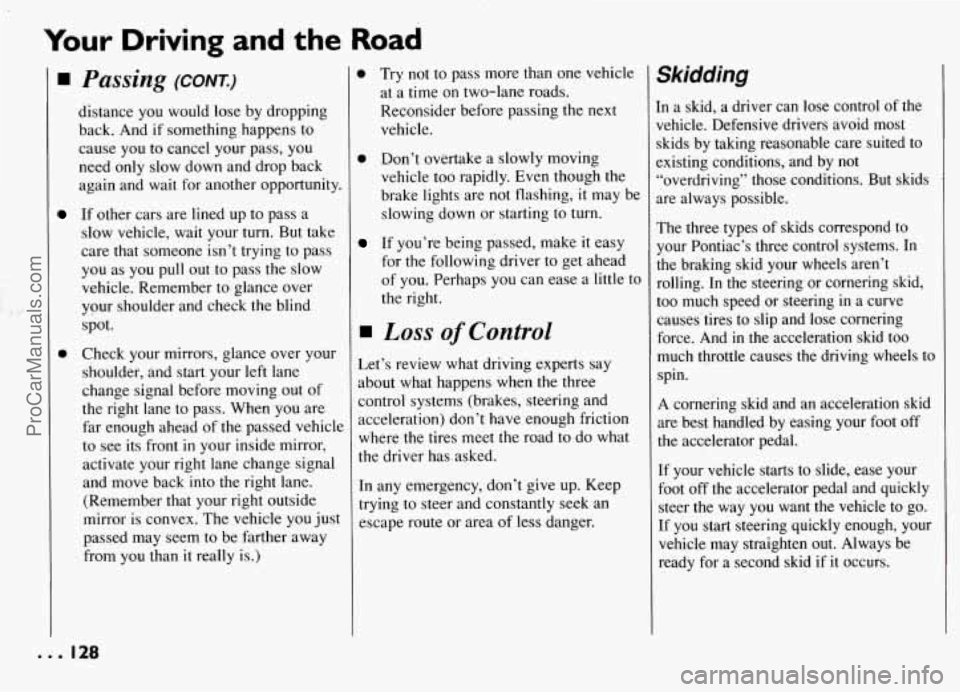
Your Driving and the Road
I
0
Passing (CONT.)
distance you would lose by dropping
back. And if something happens to
cause you to cancel your pass, you
need only slow down and drop back
again and wait for another opportunity.
If other cars are lined up to pass a
slow vehicle, wait your turn. But take
care that someone isn’t trying to pass
you as you pull out to pass the slow
vehicle. Remember to glance over
your shoulder and check the blind
spot.
Check your mirrors, glance over your
shoulder, and start your left lane
change signal before moving out of
the right lane to pass. When you are
far enough ahead of the passed vehicle
to see its front
in your inside mirror,
activate your right lane change signal
and move back into the right lane.
(Remember that your right outside
mirror is convex. The vehicle you just
passed may seem to be farther away
from you than
it really is.)
B Try not to pass more than one vehicle
at a time on two-lane roads.
Reconsider before passing the next
vehicle.
B Don’t overtake a slowly moving
vehicle too rapidly. Even though the
brake lights are not flashing, it may be
slowing down or starting to
turn.
If you’re being passed, make it easy
for the following driver to get ahead
of you. Perhaps you can ease a
little to
the right.
Loss of Control
Let’s review what driving experts say
about what happens when the three
control systems (brakes, steering and
acceleration) don’t have enough friction
where the tires meet
the road to do what
the driver has asked.
In any emergency, don’t give up. Keep
trying to steer and constantly seek an
escape route or area of less danger.
Skidding
[n a skid, a driver can lose control of the
vehicle. Defensive drivers avoid most
skids by taking reasonable care suited to
:xisting conditions, and by not
,‘overdriving” those conditions. But skids
we always possible.
The three types of skids correspond to
your Pontiac’s three control systems. In
the braking skid your wheels aren’t
rolling. In the steering or cornering skid,
too much speed or steering in a curve
causes’tires to slip and lose cornering
force. And in the acceleration skid too
much throttle causes the driving wheels to
spin.
A cornering skid and an acceleration skid
are best handled by easing your foot off
the accelerator pedal.
If your vehicle starts to slide, ease your
foot off the accelerator pedal and quickly
steer the way you want the vehicle to go.
If you start steering quickly enough, your
vehicle may straighten out. Always be
ready for a second skid if
it occurs.
... 128
ProCarManuals.com
Page 130 of 274

Of course, traction is reduced when water, I
snow, ice, gravel, or other material is on
the road. For safety, you’ll want to slow
down and adjust your driving to these conditions. It is important to slow down
on slippery surfaces because stopping
distance will be longer and vehicle
control more limited.
While driving on a surface with reduced traction, try your best to avoid sudden
steering, acceleration, or braking
(including engine braking by shifting to a
lower gear). Any sudden changes could cause the tires to slide.
You may not?
realize the surface is slippery until your
vehicle is skidding. Learn to recognize
warning clues
-- such as enough water;
ice or packed snow on the road to make a
“mirrored surface”
-- and slow down
when you have any doubt.
Remember: Any anti-lock braking system (ABS) helps avoid only the braking skid.
I
Driving at Night
Night driving is more dangerous than day
driving. One reason is that some drivers
are likely to be impaired
-- by alcohol or
drugs, with night vision problems, or by
fatigue.
Here are some tips on night driving.
Drive defensively.
0 Don’t drink and drive.
Adjust your inside rearview mirror to
reduce the glare from headlights
behind you.
0 Since you can’t see as well, you may
need to slow down and keep more
space between you and other vehicles.
0 Slow down, especially on higher
speed roads. Your headlights can light
up only
so much road ahead.
In remote areas, watch for animals.
If you’re tired, pull off the mad in a
safe place and rest.
Night Wsion
No one can see as well at night as in the
daytime. But as we get older these
differences increase. A 50-year-old driver
may require at least twice as much. light to
see the same thing at night as a
20-year-old.
What you do in the daytime can also
affect your night vision. For example, if
you spend the day
in bright sunshine you
are wise to wear sunglasses. Your eyes
will have less trouble adjusting to night.
But
if you’re driving, don’t wear
sunglasses at night. They may cut down
on glare from headlights, but they also
make a lot of things invisible.
129...
ProCarManuals.com
Page 138 of 274
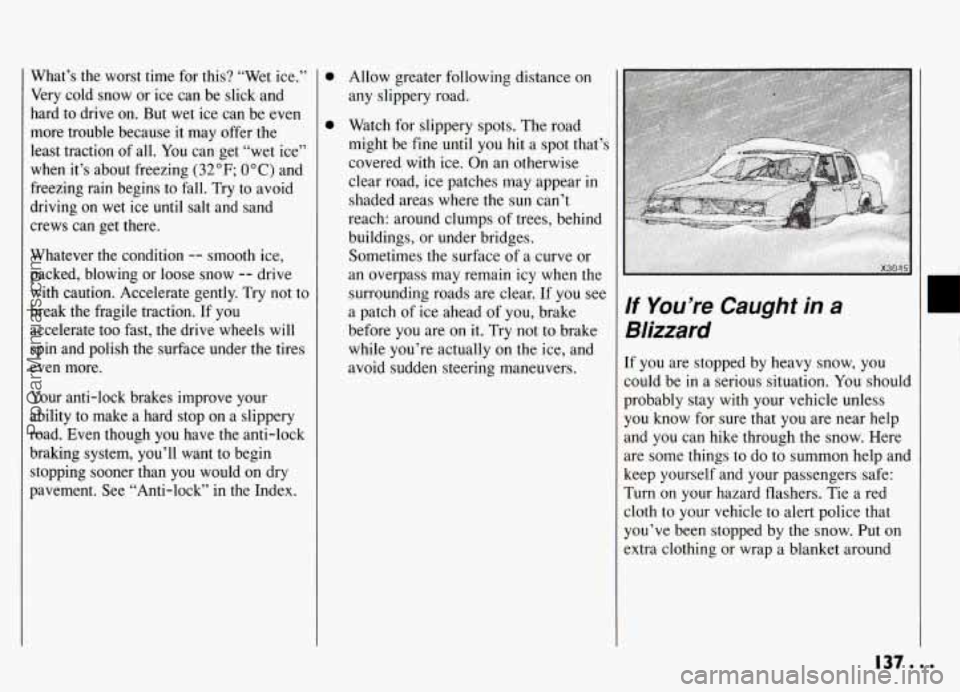
What’s the worst time for this? “Wet ice.”
Very cold snow or ice can be slick-and
hard to drive on. But wet ice can be even
more trouble because it may offer the
least traction of all. You can get “wet ice”
when it’s about freezing
(32°F; OOC) and
freezing rain begins to fall. Try to avoid
driving on wet ice until salt and sand
crews can get there.
Whatever the condition -- smooth ice,
packed, blowing or loose snow
-- drive
with caution. Accelerate gently. Try not to
break the fragile traction. If you
accelerate too fast, the drive wheels will
spin and polish the surface under the tires
even more.
Your anti-lock brakes improve your
ability to make a hard stop on a slippery
road. Even though you have the anti-lock
braking system, you’ll want to begin
stopping sooner than you would on dry
pavement. See “Anti-lock” in the Index.
0
0
Allow greater following distance on
any slippery road.
Watch for slippery spots. The road
might be fine until you hit a spot that’s
covered with ice. On an otherwise
clear road, ice patches may appear
in
shaded areas where the sun can’t
reach: around clumps of trees, behind
buildings, or under bridges.
Sometimes the surface
of a curve or
an overpass may remain icy when the
surrounding roads are clear. If you see
a patch of ice ahead of you, brake
before you are on it. Try not to brake
while you’re actually on the ice, and
avoid sudden steering maneuvers.
If You’re Caught in a
Blizzard
If you are stopped by heavy snow, you
could be
in a serious situation. You should
probably stay with your vehicle unless
you know for sure that you are near help
and you can hike through the snow. Here
are some things to do to summon help and
keep yourself and your passengers safe:
Turn on your hazard flashers. Tie a red
cloth to your vehicle to alert police that
you’ve been stopped by the snow.
Put on
extra clothing or wrap a blanket around
ProCarManuals.com
Page 140 of 274
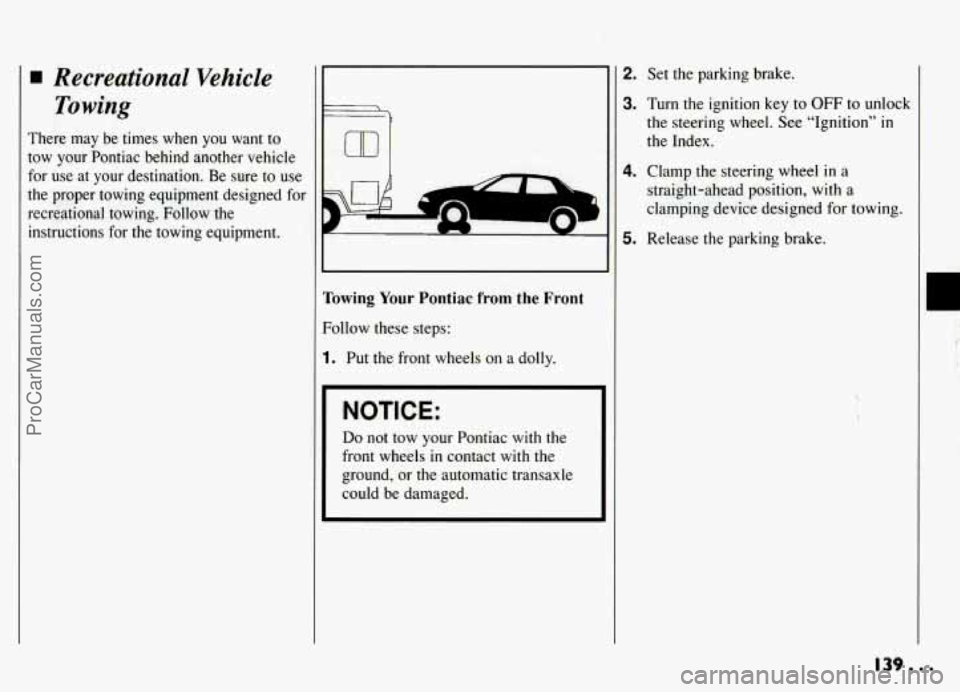
Recreational Vehicle
Towing
There may be times when you want to
tow your Pontiac behind another vehicle
for use at your destination. Be sure to use
the proper towing equipment designed for
recreational towing. Follow the instructions for the towing equipment.
-
Towing Your Pontiac from the Front
Follow these steps:
1. Put the front wheels on a dolly.
NOTICE:
Do not tow your Pontiac with the
front wheels in contact with the
ground, or
the automatic transaxle
could
be damaged.
2. Set the parking brake.
3. Turn the ignition key to OFF to unlock
the steering wheel.
See “Ignition” in
the Index.
4. Clamp the steering wheel in a
straight-ahead position, with a
clamping device designed for towing.
5. Release the parking brake.
C
139...
ProCarManuals.com